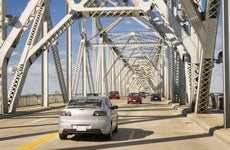What to do after a hit-and-run in Kentucky

The Bankrate promise
At Bankrate, we strive to help you make smarter financial decisions. To help readers understand how insurance affects their finances, we have licensed insurance professionals on staff who have spent a combined 47 years in the auto, home and life insurance industries. While we adhere to strict , this post may contain references to products from our partners. Here's an explanation of . Our content is backed by Coverage.com, LLC, a licensed entity (NPN: 19966249). For more information, please see our .
Hit-and-runs are frustrating situations everyone hopes to avoid. Still, it’s better to be prepared rather than caught off guard should it happen. Bankrate explores the insurance implications and legal penalties of being involved in a hit-and-run in Kentucky.
Hit-and-runs in Kentucky
A hit-and-run occurs when someone involved in a motor vehicle accident leaves the scene. Typically, this happens when a driver collides with another vehicle or property and wants to escape without being held liable. Nearly 19 percent of drivers in Kentucky in 2022 were uninsured, the sixth-highest level in the U.S., according to the Insurance Information Institute. Because driving without insurance in Kentucky is illegal, an uninsured driver may be even more motivated to flee.
Kentucky hit-and-run laws
According to Kentucky hit-and-run laws, if a driver is involved in any motor vehicle accident causing property damage, injury or death, they must stop, evaluate the situation and render assistance to the other involved parties. If you cause property damage but no other driver is involved — like hitting a parked car in a parking lot — leaving a note with your name, address, vehicle registration and insurance information will usually suffice as taking responsibility.
But leaving the scene of an accident in KY could result in several penalties including:
- Fines up to $500
- Points against your driving record
- More expensive insurance premiums
- A class A misdemeanor
- Criminal charges that result in jail time
How hit-and-runs impact car insurance rates in Kentucky
If you are the victim of a hit-and-run in Kentucky, the incident typically won’t be surchargeable on your insurance policy. However, circumstances may vary by provider and state. Even if you were to experience an increase in your premium, it would likely be much less than if you were at fault.
When you are found at fault for any accident, you will likely see an increase in your insurance rates. If you are later caught after having fled the scene, you’re likely to get a motor vehicle violation for leaving, as well. Since there would be two incidents on record instead of one, the premium increase you might face would typically be much higher than if you stayed at the scene of the accident.
The average annual cost of car insurance in Kentucky for drivers with clean records is $2,540 for full coverage and $761 for minimum coverage. These rates are in line with the national averages of $2,542 and $740, respectively. However, a standard at-fault accident could add $1,000 or more to your annual premium — and a hit-and-run conviction could inflate your rates even further.
4 things to do after a hit-and-run in Kentucky
Knowing what to do after a hit-and-run in Kentucky can prepare you in the event you are ever the victim of such an accident. Experts recommend that you make sure everyone is okay, get help for anyone injured and, if possible, try to make observations that will help the police department locate the driver who caused the hit-and-run.
Consider the following steps:
- Stop and evaluate yourself and others for injuries. Determine if anyone is injured, and if so, immediately call for emergency services. You might feel fine at first, but seeking a professional medical opinion may be a good idea.
- Try to observe the vehicle that caused the accident as they are leaving the scene. Note any identifying factors such as the license plate number, vehicle type, driver description or even bumper stickers or specific marks on the vehicle. Writing this information down might be helpful.
- Report the accident. As soon as you have evaluated the situation, call the police to the scene. Not only will a law enforcement officer create an official police report, which could be helpful for an insurance claim, but they may also be able to help locate the at-fault party.
- Collect your own evidence. The scene of an accident can be chaotic. Although it is not always possible, it can be helpful if you collect your own evidence — so long as you do not interfere with the official police investigation. Take photos of your vehicle’s damage and the surrounding area, gather contact information for any witnesses and take note if any public locations in the vicinity may have a video recording of the accident.
Learn more: How to file a car insurance claim
Will insurance cover a hit-and-run?
If you are involved in an accident, your car insurance may protect you financially by covering some of the damage. However, this ultimately depends on the state you live in, the laws that are in place and the coverage on your policy. Kentucky is a no-fault state, and more specifically, a “choice” no-fault state. This means that each driver must be offered a minimum amount of personal injury protection (PIP) and uninsured/underinsured motorist coverage (UM/UIM), but it is up to them whether to purchase it or not.
PIP helps pay for your own injuries regardless of fault. If your policy includes PIP, coverage is afforded for medical expenses, wage losses and essential services. UM/UIM coverage may help you recoup losses, too.
If you are the victim of a hit-and-run accident in Kentucky, your auto insurance policy can help pay for your property damage if you have certain coverage types, as well — namely, collision coverage. You will likely be required to pay your deductible, though.
Talking to your agent or a representative from your company about how your policy would respond to a hit-and-run may be the best way to ensure you’re prepared.
Frequently asked questions
-
-
The average cost of car insurance in the United States is $2,542 per year for full coverage and $740 for minimum coverage. However, the amount you pay for insurance will vary based on factors like your ZIP code, driving record, insurance history, vehicle type, desired coverage and more. Further, insurers weigh these factors differently, so rates vary by company. Experts recommend getting quotes for the same coverage types and levels from several car insurance companies to determine which one can offer you the best rate for the coverage you need.
-
Each state sets its own minimum insurance requirements and not carrying the proper insurance can result in serious penalties. In Kentucky, drivers are required to carry $25,000 per person and $50,000 per accident in bodily injury liability and $25,000 per accident in property damage liability. A policy with a single limit of $60,000 is also compliant with Kentucky law.
Kentucky auto insurers are required to offer uninsured/underinsured motorist coverage to all policyholders, but the coverage can be declined via a waiver. Minimum limits in Kentucky are $25,000 per person and $50,000 per accident in uninsured/underinsured motorist bodily injury.
Since Kentucky is a no-fault state, each driver must be offered at least $10,000 per person per accident in personal injury protection (PIP) coverage, as well. PIP can help pay for medical expenses, lost wages and other costs due to an injury if you are involved in an accident, regardless of who was at fault. However, you may forego PIP coverage if you drive a motorcycle. Experts recommend speaking with an insurance professional who can fully explain your options and help you design a policy that works best for your circumstances.
-
Picking just one best car insurance company in Kentucky can be tricky, considering how personalized rates can be, how unique coverage needs often are and how varied insurers and their products can be. For instance, if you’re looking for a policy that will accommodate you as a high-risk driver, you might choose a different carrier than if you were looking for coverage for a classic car. Once you’ve identified your needs, you can read reviews and request quotes from several companies to see which offers you the most competitive rate on the coverage you seek.
-
With regard to your driving record, Kentucky uses a point system for traffic violations. Drivers convicted of leaving the scene of an accident (aka a hit-and-run) will earn six demerit points. Points will remain on the driver’s record for two years. After two years, the points are dropped, but the conviction remains for five. Anyone who accumulates 12 or more points in a two-year period may have their license suspended. However, a hit-and-run stays on a driver’s criminal record indefinitely. In Kentucky, a hit-and-run that only involves property damage is considered a class A misdemeanor. If serious injury or death occurs, the criminal classification increases to a class D felony.
-
Related Articles



